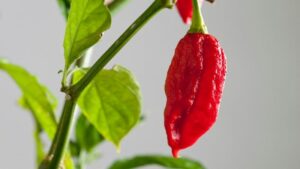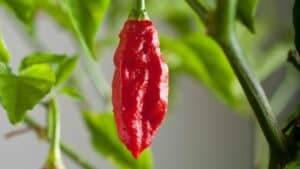Have you been growing ghost peppers only to find some odd purple ones developing? Not to worry – purple ghost peppers are totally normal.
These exotic purple beauties occur thanks to natural ripening, weather fluctuations, soil conditions, and other factors. While not as hot as classic red ghost peppers, they still pack some serious punch.
Ghost peppers turn purple closer toward full ripeness. Sometimes the purple coloration is due to the pepper’s response to sunlight and temperature. Other times, purple ghost peppers are a slight variant of the usual red ghost pepper.
In this article, we’ll explore:
- What causes ghost peppers to turn purple
- How purple ghost peppers compare to red in terms of heat
- Growing tips for vibrant, multi-colored ghost peppers
- Frequently asked questions about these unusual purple peppers
So if you’ve got violet peppers, don’t panic. Harness their unique color and flavor to add some unexpected heat to your meals. Let’s dive into the details on purple ghost peppers!
Are Purple Ghost Peppers Normal?
Purple ghost peppers are perfectly normal and are the rarest forms of ghost peppers. There are several reasons why your ghost peppers might turn purple. Sometimes, the purple coloration is a rite of passage into maturity. Some ghost peppers turn purple from green and gradually get lighter to yield the usual red ghost pepper.
Additionally, purple ghost peppers are variations of the typical red ghost pepper due to genetic modifications and other environmental factors like temperature, sunshine, soil factors, etc.
Color Variants of Ghost Peppers
The ghost pepper, also called bhut jolokia, is an absolute powerhouse pepper known for its extreme heat. This bad boy registered over 1 million Scoville Heat Units (SHU) on the
Some call the ghost pepper the world’s hottest chili pepper. This claim to flame first surfaced in 2007 when the ghost pepper won a Guinness World Record. Ever since then, it’s been a hot item in the pepper world (pun intended).
The traditional ghost pepper is red. But several variants exist, including:
- Red
- Yellow
- Orange
- White
- Brown
- Peach
- Purple
So if you see purple peppers growing, don’t panic. Let’s break down what’s causing this curious color change.
By the way if ghost pepper turn into black it may be plant disease please check here.
Below is a table showing how these ghost peppers differ from one another and relate to the traditional red ghost pepper.
| Ghost Pepper Color Variants | General Characteristics |
|---|---|
| Red Ghost Pepper | The most widely known and the hottest among the ghost pepper types. |
| Yellow Ghost Pepper | They look similar to the red one but not as hot. |
| Orange Ghost Pepper | They are slightly more prominent than the red ones, about six inches long and equally spicy. |
| White Ghost Peppers | They have more of an off-white color or tinted yellow. Smooth skin and citrus flavor. |
| Brown Ghost Peppers | They have a more intense aroma, slightly sweet with an earthy undertone, and not as hot as red ones. |
| Peach Ghost Peppers | Same spiciness as the red ones with a more fruity after taste. |
| Purple Ghost Peppers | They are the rarest type, most petite in size, and milder taste. |
Why Are My Ghost Peppers Turning Purple?
Seeing purple peppers can be alarming if you didn’t plant them on purpose. But rest assured, there are natural explanations for purple ghost peppers.
It’s Part of the Ripening Process
Many peppers turn purple as they transition from unripe green to fully ripe red. As ghost peppers mature, their color evolves through several shades:
Green → Yellow → Orange → Purple → Red
So purple is just a stop along the way to reddest. If you notice green ghost peppers morphing to purple, congrats – they’re getting close to peak ripeness.
Temperature Fluctuations
Did you have some unusually cold nights or hot days? Temperature extremes can impact pepper pigmentation, causing an abnormal purple color. Once temps stabilize, the peppers should resume their normal ripening process.
Sun Exposure
Too much sun can actually stress out pepper plants. This environmental stress alters their chlorophyll production, leading to thedevelopment of purple pigments called anthocyanins. Adding some shade should help newly purple peppers return to red.
Soil Composition
The nutrients in your soil, especially phosphorus, can influence pepper color. Insufficient phosphorus causes purple peppers. Test your soil and amend it with bone meal or rock phosphate if needed.
Natural Variation
Sometimes purple peppers occur randomly thanks to the genetic lottery. Cross-pollination from bees, wind, and other factors introduces variation. If you like the look of purple peppers, collect their seeds and selectively breed more.
Disease
While purple color alone likely isn’t problematic, watch for other signs of disease like spots, wilting, or rotting. Fungal infections like anthracnose sometimes cause a temporary purple hue. Remove infected plants right away to protect the rest.
Is There Any Science Behind Ghost Peppers Turning Purple?
The scientific explanation for ghost peppers turning purple lies in understanding agricultural hybridization and pollination.
Two types of hybridization exist for growing various kinds and colors of ghost peppers:
- Planned Hybridization: The farmer is intentional about inter- and intra- breeding various pepper species.
- Accidental Hybridization: This is the natural type of hybridization where the farmer has no control. It is usually the type of hybridization when plants are allowed to grow in the wild. Also, birds, insects, wind and other factors of natural pollination contribute to accidental hybridization.
When peppers grow in the wild, pollination occurs naturally, causing them to blend several genetic and phenotypic properties of different species to yield a hybrid pepper. Essentially, the ghost pepper, also known as Bhut Jolokia, is a hybrid form of chili that is indigenous to Indians.
The environmental factors and warm climate make it easy for ghost peppers to grow in India. However, when Bhut Jolokia won the Guinness record for the world’s hottest pepper, it became necessary to understand more about it.
Interestingly, the world is constantly seeking ways to grow hotter peppers than we already have. As a result, genetic modification and hybridization of peppers were discovered. Ghost peppers are, therefore, a naturally occurring hybrid of two types of peppers, Capsicum chinense × Capsicum frutescens.
So a fusion of qualities from both types or species of peppers makes further genetic variations of pepper limitless. Besides, the world keeps growing more species of super hot peppers by cross-pollinating several hot peppers to become the world’s hottest pepper.
Fun Fact: The continuous quest to grow super-hot peppers forms a significant part of the pleasure of setting up social pepper eating contests for fun.
Growing Tips for Vibrant Ghost Peppers
To enjoy the full range of ghost pepper colors in your garden, follow these tips:
- Plant in fertile soil amended with compost
- Use row covers to protect from temperature swings
- Water 1-2 inches per week and mulch to retain moisture
- Fertilize every 2-3 weeks with a balanced vegetable formula
- Stake taller plants to prevent stress and sunscald
- Monitor for pests and diseases and treat organically if found
With a little TLC, your ghost peppers will turn out gorgeous…and outrageously hot.
Frequently Asked Questions
Can Ghost Peppers Be Purple?
Yes, ghost peppers can be purple and exist as a rare variant of the Bhut Jolokia. Purple ghost peppers are the mildest variants of ghost peppers. However, they are about 125 times hotter than the average Jalapeno pepper. Purple ghost peppers measure up to 800,000 Scoville heat units and are naturally occurring.
What Color Should Ghost Pepper Be When Picked?
Ghost peppers reach their final color when they attain maturity and full ripeness. Generally, the final color transformation of ghost pepper is red. It also depicts when they are at their hottest. The best time to harvest ghost peppers is when they attain full maturity and ripeness. However, some people still harvest ghost peppers green and unripe.
What Are the Color Shades of Ghost Peppers?
Ghost peppers start as green when unripe and transform through several colour shades to reach full ripeness and maturity. Sometimes, they become yellow, then gradually turn orange, brown, and purple, from where they lighten progressively into ripe red. However, the color transformation is not a definite pattern for the ripening process, as there are different types of ghost peppers.
Can you eat purple ghost peppers?
Yes, purple ghost peppers are edible, although not as face-meltingly hot as red ones. Their flavor is milder too. Use them just like other peppers.
What’s the difference between red and purple ghost peppers?
Red ghost peppers are the classic variety known for extreme heat of over 1 million SHU. Purple are a milder genetic mutation with a Scoville rating around 125,000.
Turn Up the Heat with Ghost Peppers
Adding ghost peppers to your garden is sure to make things…interesting. Their otherworldly heat transforms any dish into a five-alarm fire. Harnessing that intensity takes finesse, but the payoff of amazing flavor is worth it.
So don’t fear the purple peppers! Their odd color is usually natural. With proper care, you’ll be harvesting armloads of gorgeous ghost peppers in every hue. Just be sure to have plenty of milk and ice cream on hand to tame the heat!





